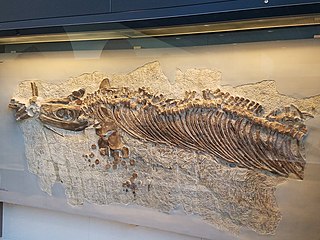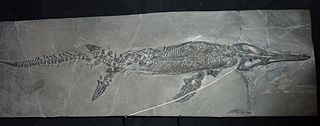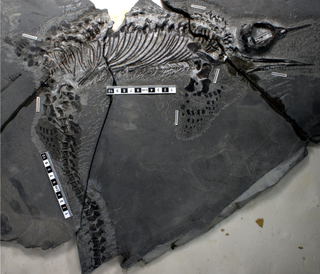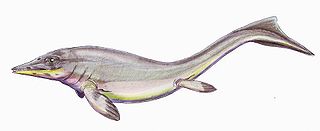
Ichthyosauria is an order of large extinct marine reptiles sometimes referred to as "ichthyosaurs," although the term is also used for wider clades that the order resides in.

Ichthyopterygia was a designation introduced by Sir Richard Owen in 1840 to designate the Jurassic ichthyosaurs that were known at the time, but the term is now used more often for both true Ichthyosauria and their more primitive early and middle Triassic ancestors.

Shonisaurus is a genus of very large ichthyosaurs. At least 37 incomplete fossil specimens of the marine reptile have been found in the Luning Formation of Nevada, USA. This formation dates to the late Carnian age of the late Triassic period, about 237–227 million years ago.

Cymbospondylus is an extinct genus of large ichthyosaurs, of which it is among the oldest representatives, that lived during the Anisian stage of the Middle Triassic in what are now North America and Europe. The first known fossils of this taxon are a set of more or less complete vertebrae which were discovered in the 19th century in various mountain ranges of Nevada, in the United States, before being named and described by Joseph Leidy in 1868. It is in the beginning of the 20th century that more complete fossils were discovered through several expeditions launched by the University of California, and described in more detail by John Campbell Merriam in 1908, thus visualizing the overall anatomy of the animal. While many species have been assigned to the genus, only five are recognized as valid, the others being considered synonymous, doubtful or belonging to other genera. Cymbospondylus was formerly classified as a representative of the Shastasauridae, but more recent studies consider it to be more basal, view as the type genus of the Cymbospondylidae.

Mixosaurus is an extinct genus of Middle Triassic ichthyosaur. Its fossils have been found near the Italy–Switzerland border and in South China.

Utatsusaurus hataii is the earliest-known ichthyopterygian which lived in the Early Triassic period. It was nearly 2.5–3 metres (8.2–9.8 ft) long with a slender body. The first specimen was found in Utatsu-cho, Miyagi Prefecture, Japan. It is the only described species in the genus Utatsusaurus and the only member of the family Utatsusauridae. The name Utatsusaurus was given after the city. The fossils have been found from the Early Triassic Osawa Formation of Miyagi Prefecture, Japan and British Columbia, Canada.

Chaohusaurus is an extinct genus of basal ichthyopterygian, depending on definition possibly ichthyosaur, from the Early Triassic of Chaohu and Yuanan, China.

Contectopalatus was a primitive ichthyosaur, an extinct fish-like marine reptile from the Middle Triassic of Germany and China. It was originally named Ichthyosaurus atavus by Quenstedt in 1852, and later reassigned to Mixosaurus. It was recognised as a separate genus by Maisch and Matzke in 1998, though other researchers have classified it as a species of Phalarodon instead.

Excalibosaurus is a monotypic genus of marine prehistoric reptiles (ichthyosaurs) that lived during the Sinemurian stage of the Early Jurassic period in what is now England. It is characterized by the extreme elongation of the rostrum, with the lower jaw about three-quarters the length of the upper jaw, giving the animal a swordfish-like look. The only known species is Excalibosaurus costini.

Grippia is a genus of early ichthyopterygian, an extinct group of reptiles that resembled dolphins. Its only species is Grippia longirostris. It was a relatively small ichthyopterygian, measuring around 1–1.5 metres (3.3–4.9 ft) long. Fossil remains from Svalbard from the specimen SVT 203 were originally assigned to G. longirostris but are now thought to have belonged to a non-ichthyopterygian diapsid related to Helveticosaurus.

Brachypterygius is an extinct genus of platypterygiine ophthalmosaurid ichthyosaur known from the Late Jurassic of England. The type species was originally described and named as Ichthyosaurus extremus by Boulenger in 1904. Brachypterygius was named by Huene in 1922 for the width and shortness of the forepaddle, and the type species is therefore Brachypterygius extremus. The holotype of B. extremus was originally thought to be from the Lias Group of Bath, United Kingdom, but other specimens suggest it more likely came from the Kimmeridgian Kimmeridge Clay of Kimmeridge Bay, Dorset, UK.

Undorosaurus is an extinct genus of ophthalmosaurid ichthyosaur known from western Russia, Svalbard, and Poland. It was a large ichthyosaur, with the type species measuring 4–6 metres (13–20 ft) long.

Hudsonelpidia is an extinct genus of small parvipelvian ichthyosaur known from British Columbia of Canada.
Isfjordosaurus is an extinct genus of ichthyopterygian marine reptile that lived during the Early Triassic. Fossils have been found on the island of Spitsbergen, part of the Svalbard archipelago off the northern coast of Norway. It was formally described by Ryosuke Motani in 1999 and contains the species Isfjordosaurus minor.
Parvinatator, from Latin, “parvus” little and “natator” swimmer, is an extinct genus of small ichthyopterygian marine reptile that lived during the Early to Middle Triassic. Its fossils have been found in British Columbia, Canada.

Thaisaurus is an extinct genus of ichthyopterygian marine reptile that lived during the Spathian. Fossils have been found in Thailand.
Mixosauridae was an early group of ichthyosaurs, living between 247.2 and 235 million years ago, during the Triassic period. Fossils of mixosaurs have been found all over the world: China, Timor, Indonesia, Italy, Germany, Spitsbergen, Switzerland, Svalbard, Canada, Alaska, and Nevada.

Parvipelvia is an extinct clade of euichthyosaur ichthyosaurs that existed from the Late Triassic to the early Late Cretaceous of Asia, Australia, Europe, North America and South America. Named by Ryosuke Motani, in 1999, it contains the basal taxa like Macgowania and Hudsonelpidia. Maisch and Matzke (2000) found in their analysis seven synapomorphies that support Parvipelvia. They also found 10 synapomorphies that support the existence of post-Triassic clade of ichthyosaurs, for which the name Neoichthyosauria was found to be available. Parvipelvians were the only ichthyosaurs to survive the Triassic-Jurassic extinction event.

This timeline of ichthyosaur research is a chronological listing of events in the history of paleontology focused on the ichthyosauromorphs, a group of secondarily aquatic marine reptiles whose later members superficially resembled dolphins, sharks, or swordfish. Scientists have documented ichthyosaur fossils at least as far back as the late 17th century. At that time, a scholar named Edward Lhuyd published a book on British fossils that misattributed some ichthyosaur vertebrae to actual fishes; their true nature was not recognized until the 19th century. In 1811, a boy named Joseph Anning discovered the first ichthyosaur fossils that would come to be scientifically recognized as such. His sister Mary would later find the rest of its skeleton and would go on to become a respected fossil collector and paleontologist in her own right.
























